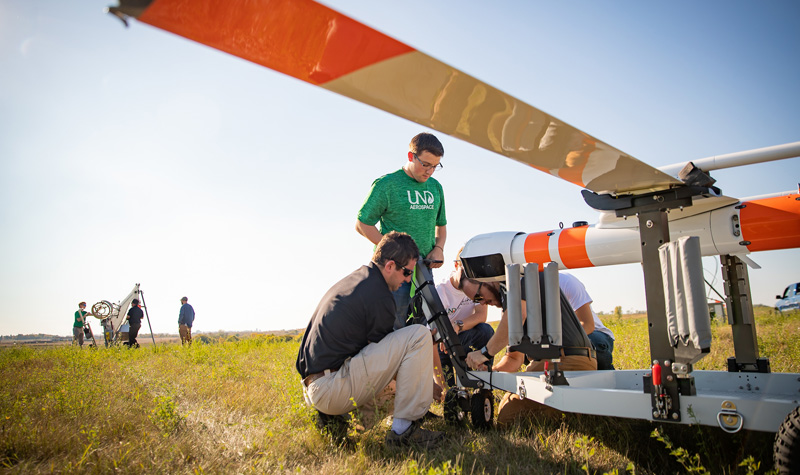UND achieves rare air — again
Students are biggest winners in UND’s selection as part of FAA’s elite new Collegiate Training Initiative

University of North Dakota Aerospace is synonymous with flight training excellence.
And as the Federal Aviation Administration (FAA) prepares for expanded use of unmanned aerial systems (UAS) in the National Airspace, UND’s flying legacy has put it among the leaders that will make it happen. UND Aerospace was just selected to be among the first institutions in the nation for the “FAA’s new Collegiate Training Initiative for UAS,” according to a recent announcement by the FAA.
The University’s participation in the program will ensure that there is a pipeline of professionally qualified graduates to meet increasing demands of the UAS industry and for integration of UAS into the National Airspace.
The overall FAA Collegiate Training Initiative (CTI) program has been in place for more than 25 years. It was first developed to help schools deliver up-to-date air traffic control training in order to provide the FAA with qualified air traffic controller applicants. UND has been involved in the Air Traffic Control-CTI program since the program’s inception.

Recently, the FAA extended the CTI program to UAS, which has now resulted in new memorandums of understanding between the FAA and an elite group of eligible institutions of higher education, including the University of North Dakota.

The FAA wrote that the program’s mission is to “collaborate with selected schools to deliver up-to-date UAS training tools, resources and guidelines that will prepare students for careers in UAS and continue to maintain the safety of the National Airspace System.”
Paul Snyder, UAS program director at the John D. Odegard School of Aerospace Sciences, said the announcement reinforces UND’s position at the forefront of UAS education and research.
In 2009, UND was the first university to establish a degree program for UAS Operations, allowing students from across the nation to be on leading edge of UAS education, training and research.

“This new level of partnership will help the FAA address labor force needs and ensure that graduates have the knowledge and skills needed to pursue a successful career,” Snyder said. “The CTI distinction reflects our attitude of wanting to continuously improve UND’s UAS program.

“As this industry develops, we’re not waiting to see what happens – we’re stepping in to be part of its rapid growth.”
Speaking from his experience guiding and instructing UND’s Air Traffic Management program, Associate Professor Paul Drechsel said that CTI partnership ensured a reliable hiring source for UND students, and has provided a standardized training program allowing UND Aerospace to excel. He sees this same scenario playing out now for UND Aerospace’s UAS students.
“With our history in ATC – going beyond minimum requirements laid out by the program and developing exceptional, qualified candidates – the FAA knows UND is going to go above and beyond with UAS,” Drechsel said. “Being part of the CTI program has been a great advantage for our past graduates, and our future graduates both in ATC and UAS will have that advantage, as well. This is a great opportunity.”
Brett Venhuizen, chair of the Department of Aviation, noted that while the UAS industry has been around for a number of years, it is still in its relative infancy, when compared to manned aviation.
“The connections we’re making with the FAA are huge, and it will be really interesting for our UAS program to be part of this new effort,” Venhuizen said. “The CTI program has been a large factor in the success of our air traffic management program, and I can see a bright future for UAS and our involvement with the FAA.”


